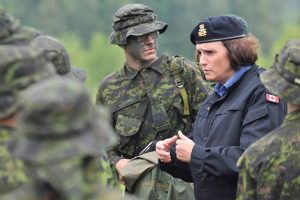Leading as a woman in the Canadian Forces
By Lookout on Oct 15, 2012 with Comments 0
Canadian women have played an essential role in all the armed conflicts in which Canada has taken part for more than a century; but it was service in the First and Second World Wars that allowed women to slowly gain recognition as our nation saw increasing numbers of women proudly serving their country in uniform.
Although these women did not set out to challenge society’s perceptions on the roles of women in the workplace, they blazed the trail for those of us serving today.
While changes since the Second World War were impressive and comprehensive, considering the restrictions to service for women up to that time, there remained many barriers to overcome, and the navy I joined in 1975 was still very traditional in its thinking.
I began my career as a Naval Communicator, but could only work in shore-based facilities as women were not allowed to serve in operational units including ships.
The Naval Reserve was considered progressive in those days as females were given limited opportunities to go to sea for training but, only during the day in smaller class vessels.
When I did navigation training as an officer, we sailed in YAGs, came into a port each afternoon, got on a bus and returned to Victoria to stay overnight on the base while the male Commanding Officer and crew stayed onboard. The next morning, we travelled to meet the ship and the same pattern repeated itself, but we had to stay within range of a bus trip back to Victoria.
Women did not march in platoons with men because our uniform skirt was tapered and did not allow us to step out with the same length of pace as men. Ranks were also differentiated for male and females, indicating in the case of the Navy that you were a Wren, and as an officer we carried a “W” to designate “woman” so when I was a Naval Lieutenant, I was Lt(N)(R)(W).
Basic training was conducted separately for men and women and trades were limited to support occupations for female non-commissioned members and officers until the mid to late 80s. When I transferred to become an officer in 1978 I was assigned one of the two support trades that were the only options for female officers, and although I was trained in Sea Logistics, there were no billets for us to serve at sea.
I joined a very different military in the mid seventies and saw first hand the challenges and barriers to women integrating into a deeply rooted male culture, career and workplace, but I also had the unique opportunity to be part of the evolution that opened doors and opportunities for today’s generation of service women.
In comparing notes with other female colleagues who have been “firsts” in CF leadership positions, we all agree that we wanted the focus to be on our abilities and experience, not our gender and we wanted to be treated as equals, not always “examples.”
As Canadian society has adjusted its views of women in leadership roles across a range of occupations, so too has the Canadian military. We’ve come a long way and the CF has worked hard to create an environment that offers every possible opportunity to everyone who chooses theexciting and rewarding challenge of a military career – be it long term or a part-time job.
Canada is now a world leader in opportunities for women serving in the forces and we are an example to not only other militaries, but the nations in which we serve on operations and postings.
I did not set out to be a trend setter or “first” in any of the positions to which I aspired and ultimately achieved. I was inspired and encouraged by many other leaders, some of whom have been female, and I was given a series of progressive challenges and opportunities to develop my abilities as a leader in this institution and my civilian career.
I feel extremely proud and somewhat intimidated to consider myself part of the history of women in the CF and a role model for future female leaders.
Rear-Admiral Jennifer Bennett, Special Contributor
Filed Under: Top Stories
About the Author:






